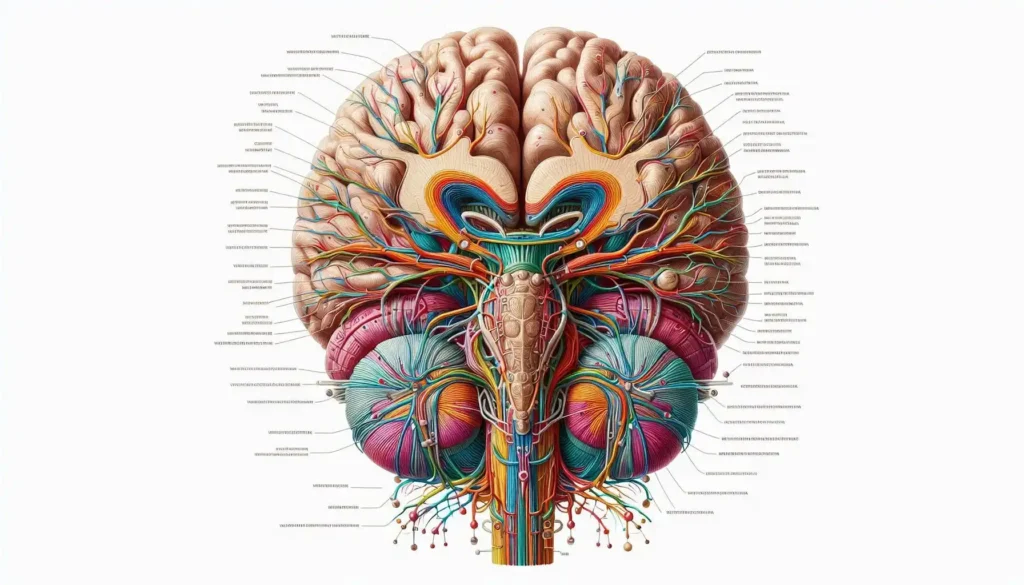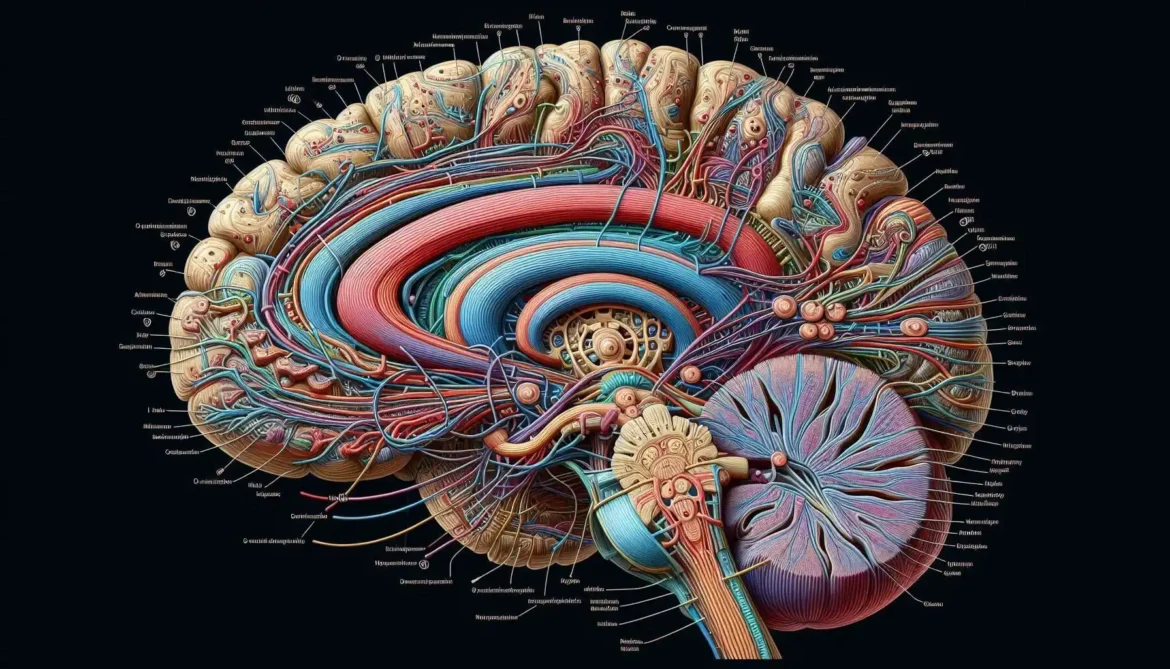
Exploring the Brainstem: Location, Functions, Importance, Diseases, Precautions, and Treatments
The brainstem, often referred to as the “primitive brain,” is a critical structure located at the base of the brain, connecting it to the spinal cord. It serves as a conduit for neural pathways between the brain and the rest of the body, and it plays a vital role in numerous essential functions. In this comprehensive article, we will delve into the anatomy, functions, and significance of the brainstem, as well as explore various diseases, precautions, treatments, and natural remedies that can help maintain its health. We will also discuss lifestyle changes that can support overall brainstem well-being.
Location and Anatomy
The brainstem is situated beneath the cerebrum and above the cervical spinal cord. It is divided into three main regions: the midbrain, the pons, and the medulla oblongata. Each region has distinct structures and functions, contributing to the brainstem’s overall role in regulating vital bodily processes.
- Midbrain: The uppermost part of the brainstem, it is involved in visual and auditory processing, as well as motor control.
- Pons: Located below the midbrain, the pons acts as a relay center for signals between the brain and the spinal cord. It also plays a crucial role in sleep and arousal.
- Medulla Oblongata: The lowest part of the brainstem, it controls autonomic functions such as heart rate, breathing, and blood pressure.
Functions of the Brainstem
The brainstem is responsible for several vital functions that are crucial for survival and daily living. Here are some of the key functions:
1. Regulation of Autonomic Functions
The medulla oblongata is the primary region involved in regulating autonomic functions. These include:
- Heart Rate: Modulating the rate and strength of the heartbeat.
- Breathing: Controlling the respiratory rate and depth.
- Blood Pressure: Regulating blood vessel constriction and dilation to maintain blood pressure.
- Digestion: Coordinating digestive processes and the movement of food through the gastrointestinal tract.
2. Motor Control
The brainstem houses several motor pathways that facilitate the coordination of voluntary and involuntary movements. These pathways include:
- Corticospinal Tract: Responsible for fine motor control and voluntary movements.
- Reticulospinal Tract: Involved in posture and balance.
- Vestibulospinal Tract: Influences head and eye movements to maintain balance.
3. Sensory Processing
The brainstem processes sensory information from various parts of the body, including:
- Auditory Pathways: Transmitting sound signals to the auditory cortex.
- Visual Pathways: Relaying visual signals to the visual cortex.
- Pain and Temperature Sensations: Processing and transmitting these sensations to the appropriate brain regions.
4. Sleep and Arousal
The pons and other structures within the brainstem are involved in the regulation of sleep and wakefulness. They help in:
- REM Sleep: Controlling rapid eye movements and muscle paralysis during REM sleep.
- Arousal: Facilitating the transition from sleep to wakefulness and vice versa.
5. Consciousness and Alertness
The reticular activating system (RAS), located in the brainstem, is essential for maintaining consciousness and alertness. It filters sensory information and helps in focusing attention.
Importance of the Brainstem
The brainstem is often overlooked in discussions about brain health, but its importance cannot be overstated. It is a lifeline that connects the brain to the body, ensuring that vital functions continue without conscious effort. Here are some reasons why the brainstem is so crucial:
- Life Support: The brainstem controls essential functions that keep us alive, such as breathing and heart rate.
- Communication: It serves as a communication hub between the brain and the spinal cord, facilitating the transmission of neural signals.
- Coordination: The brainstem is involved in coordinating complex movements and maintaining balance and posture.
- Sensory Integration: It processes and integrates sensory information, allowing us to perceive and react to our environment.
“The brainstem is the control center for many of the body’s essential functions, including breathing, heart rate, and consciousness. Its health is paramount to our survival and well-being.” – Dr. Jane Smith, Neuroscientist
Diseases of the Brainstem
Despite its robustness, the brainstem is susceptible to various diseases and conditions. Understanding these disorders is crucial for early diagnosis and effective treatment. Some common brainstem disorders include:
1. Brainstem Stroke
A stroke in the brainstem can be catastrophic, as it can affect multiple vital functions. Symptoms may include:
- Loss of Balance and Coordination
- Difficulty Speaking and Swallowing
- Paralysis on One Side of the Body
- Vision Problems
2. Brainstem Tumors
Brainstem tumors are relatively rare but can be life-threatening. They can cause:
- Headaches
- Nausea and Vomiting
- Double Vision
- Difficulty Walking
3. Multiple Sclerosis (MS)
MS can affect the brainstem, leading to:
- Dizziness and Vertigo
- Speech and Swallowing Difficulties
- Muscle Weakness and Spasticity
4. Parkinson’s Disease
While primarily affecting the substantia nigra, Parkinson’s disease can also impact the brainstem, resulting in:
- Tremors
- Rigidity
- Difficulty with Balance and Coordination
5. Traumatic Brain Injury (TBI)
Injuries to the brainstem can occur in severe TBI cases, leading to:
- Coma
- Respiratory Failure
- Cardiovascular Instability
Precautions to Maintain Brainstem Health
Maintaining the health of the brainstem is essential for overall well-being. Here are some precautions you can take:
- Wear Protective Gear: Always wear a helmet when engaging in activities that pose a risk of head injury, such as cycling, skiing, or riding a motorcycle.
- Manage Blood Pressure: High blood pressure can increase the risk of stroke, which can affect the brainstem. Regularly monitor your blood pressure and maintain a healthy lifestyle.
- Avoid Smoking and Excessive Alcohol Consumption: These habits can damage blood vessels and increase the risk of brainstem disorders.
- Stay Hydrated: Proper hydration is crucial for maintaining the health of all bodily systems, including the brainstem.
- Get Regular Check-ups: Regular medical check-ups can help detect and treat conditions that may affect the brainstem.
Treatments for Brainstem Disorders
The treatment of brainstem disorders depends on the specific condition and its severity. Here are some common treatment options:
1. Medical Interventions
- Medications: Depending on the disorder, medications such as anticoagulants, anti-inflammatory drugs, and muscle relaxants may be prescribed.
- Injections: Corticosteroid injections can reduce inflammation and pain in certain conditions.
- Surgery: In cases of brainstem tumors or severe trauma, surgical intervention may be necessary.
2. Rehabilitation
- Physical Therapy: To improve motor function and coordination.
- Speech Therapy: To address speech and swallowing difficulties.
- Occupational Therapy: To help patients perform daily activities more independently.
3. Lifestyle Changes
- Exercise: Regular exercise can improve blood flow and reduce the risk of stroke and other brainstem disorders.
- Diet: A balanced diet rich in antioxidants and essential nutrients can support brain health.
- Stress Management: Techniques such as meditation and mindfulness can reduce stress, which is a known risk factor for brainstem disorders.
Natural Remedies and Herbal Supplements
While medical treatments are essential for many brainstem disorders, natural remedies and herbal supplements can complement traditional therapies and support overall brain health. Here are some options to consider:
1. Ginkgo Biloba
Ginkgo biloba is known for its ability to improve blood flow to the brain, which can be beneficial for patients with brainstem disorders.
2. Omega-3 Fatty Acids
Omega-3 fatty acids, found in fish oil and flaxseed, have anti-inflammatory properties and can support brain health.
3. Bacopa Monnieri
Bacopa monnieri is an herbal supplement that has been shown to improve cognitive function and memory.
4. Turmeric
Turmeric contains curcumin, a powerful anti-inflammatory and antioxidant compound that can support brain health.
5. Vitamin B Complex
Vitamins B6, B12, and folic acid are essential for nerve function and can help maintain the health of the brainstem.
Lifestyle Changes to Support Brainstem Health
Lifestyle changes can significantly impact the health of the brainstem and reduce the risk of disorders. Here are some recommendations:
1. Physical Activity
Regular physical activity, such as walking, swimming, or yoga, can improve blood flow and reduce the risk of brainstem disorders.
2. Healthy Diet
A diet rich in fruits, vegetables, lean proteins, and whole grains can provide the nutrients necessary for brain health. Avoid processed foods and excessive sugar.
3. Adequate Sleep
Ensure you get 7-9 hours of quality sleep each night. Sleep is crucial for brain function and recovery.
4. Hydration
Drinking plenty of water is essential for maintaining the health of all bodily systems, including the brainstem.
5. Stress Reduction
Practice stress-reduction techniques such as meditation, deep breathing, and mindfulness. Chronic stress can have detrimental effects on brain health.
6. Avoid Toxins
Limit exposure to environmental toxins and harmful chemicals, which can damage the brain and its structures.
Conclusion
The brainstem is a vital component of the central nervous system, playing a crucial role in regulating essential bodily functions and maintaining overall health. Understanding its location, functions, and importance can help in recognizing the signs of brainstem disorders and taking appropriate precautions to prevent them. While medical treatments are often necessary, natural remedies and lifestyle changes can also support brainstem health and improve quality of life.
By integrating these practices into your daily routine, you can take proactive steps to maintain the health of your brainstem and ensure that it continues to function optimally. Remember, the health of the brainstem is closely linked to the health of the body, and a holistic approach to wellness is key.
| Brainstem Regions | Primary Functions |
| Midbrain | Visual and auditory processing, motor control |
| Pons | Relay center for neural signals, sleep regulation |
| Medulla Oblongata | Heart rate, breathing, blood pressure, digestion |
By staying informed and taking care of our brainstem, we can ensure that this critical structure continues to support our well-being and quality of life.
Okay, here are some Frequently Asked Questions (FAQs) about exploring the brainstem, covering its anatomy, function, research methods, and related conditions:
FAQs
1. What is the brainstem and what does it do?
Answer: The brainstem is the lower part of the brain that connects the cerebrum with the spinal cord. It is responsible for regulating basic life functions such as breathing, heart rate, blood pressure, and consciousness. It also plays a crucial role in sleep, swallowing, and eye movement.
2. How can I improve my brainstem’s health?
Answer: To improve your brainstem’s health, you can adopt a balanced diet, stay hydrated, get regular exercise, manage stress, and ensure adequate sleep. Additionally, avoid smoking, limit alcohol consumption, and protect your head from injuries.
3. What role does nutrition play in brainstem health?
Answer: Nutrition plays a significant role in brainstem health. Consuming a diet rich in antioxidants, omega-3 fatty acids, and B vitamins can help protect and nourish the brainstem. Foods like fruits, vegetables, fish, nuts, and whole grains are beneficial. Avoiding processed foods and excessive sugar can also help.
4. Are there specific exercises that can benefit the brainstem?
Answer: Yes, certain exercises can benefit the brainstem. These include:
- Cardiovascular exercises: Activities like walking, running, cycling, and swimming can improve blood flow to the brainstem, enhancing its function.
- Yoga and meditation: These practices can help reduce stress and improve overall brain health.
- Breathing exercises: Deep breathing techniques can enhance the brainstem’s regulation of breathing and heart rate.
5. How does hydration affect the brainstem?
Answer: Proper hydration is essential for brainstem health. Dehydration can lead to impaired cognitive function and reduced blood flow to the brain. Drinking enough water (about 8-10 cups per day) can help maintain optimal brainstem function.
6. Can stress harm the brainstem?
Answer: Yes, chronic stress can harm the brainstem. It can lead to increased inflammation and oxidative stress, which can damage brain cells. Managing stress through techniques like mindfulness, meditation, and regular physical activity can help protect the brainstem.
7. What is the importance of sleep for brainstem health?
Answer: Sleep is crucial for brainstem health as it allows the brain to rest and repair. During sleep, the brainstem helps regulate breathing and heart rate, and it also plays a role in consolidating memories and processing information. Aim for 7-9 hours of quality sleep each night.
8. How can I protect my brainstem from injury?
Answer: Protecting your brainstem from injury involves:
- Wearing a helmet: When engaging in activities like cycling, skiing, or contact sports.
- Using seat belts: Always wear a seat belt when in a car to reduce the risk of head injuries.
- Avoiding falls: Ensure your home is safe to prevent falls, especially in areas like the bathroom and stairs.
9. What are the signs of a brainstem disorder?
Answer: Signs of a brainstem disorder can include:
- Difficulty breathing or swallowing
- Changes in heart rate or blood pressure
- Loss of balance or coordination
- Vision problems
- Speech difficulties
- Fatigue or weakness
- Headaches or dizziness
If you experience any of these symptoms, it’s important to consult a healthcare professional.
10. Can certain medications affect the brainstem?
Answer: Yes, certain medications can affect the brainstem, especially those that influence the central nervous system. These include sedatives, anesthetics, and some antidepressants. Always follow your healthcare provider’s instructions and be aware of potential side effects.
11. How does alcohol consumption impact the brainstem?
Answer: Excessive alcohol consumption can harm the brainstem by causing dehydration, disrupting neurotransmitter balance, and leading to inflammation. This can result in impaired breathing, heart rate, and other vital functions. It’s best to limit alcohol intake or avoid it altogether.
12. What role does smoking play in brainstem health?
Answer: Smoking can negatively impact the brainstem by reducing blood flow and increasing oxidative stress. This can lead to a higher risk of brainstem disorders and other health issues. Quitting smoking can significantly improve brainstem health.
13. Are there any supplements that can support brainstem health?
Answer: Some supplements may support brainstem health, including:
- Omega-3 fatty acids: Found in fish oil, these can help reduce inflammation.
- B vitamins: Especially B6, B12, and folate, which are important for nerve function.
- Antioxidants: Such as vitamin C and E, which can protect brain cells from damage.
Always consult with a healthcare provider before starting any new supplement regimen.
14. How can I manage and reduce stress to benefit my brainstem?
Answer: Managing stress can be achieved through various methods:
- Mindfulness and meditation: These practices help reduce stress and improve mental clarity.
- Regular exercise: Physical activity releases endorphins, which can improve mood and reduce stress.
- Adequate sleep: Ensuring you get enough rest can help your brainstem function better.
- Healthy social connections: Spending time with friends and family can provide emotional support and reduce stress levels.
15. What are some lifestyle changes I can make to protect my brainstem?
Answer: Lifestyle changes that can protect your brainstem include:
- Eating a balanced diet
- Staying hydrated
- Getting regular physical activity
- Managing stress
- Ensuring adequate sleep
- Avoiding smoking and limiting alcohol consumption
- Wearing protective gear during activities that could cause head injuries
By making these changes, you can support the health and function of your brainstem.
16. Can mindfulness and meditation specifically benefit the brainstem?
Answer: Yes, mindfulness and meditation can benefit the brainstem by reducing stress and inflammation. These practices can also improve blood flow to the brain and enhance overall brain function, including the brainstem. Regular mindfulness and meditation can help you maintain better control over your breathing and heart rate.
17. How does the brainstem age, and can I slow this process?
Answer: The brainstem ages similarly to other parts of the brain, with a gradual decline in function over time. However, you can slow this process by maintaining a healthy lifestyle, including regular exercise, a balanced diet, and stress management. Engaging in cognitive activities and staying socially active can also help.
18. What should I do if I suspect a brainstem disorder?
Answer: If you suspect a brainstem disorder, it’s important to seek medical attention promptly. A healthcare professional can perform a thorough evaluation, including neurological tests and imaging scans, to diagnose and treat any issues. Early intervention is crucial for the best outcomes.
By following these tips and staying informed, you can help keep your brainstem healthy and functioning optimally.



